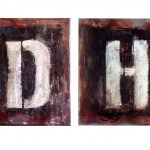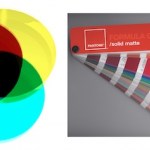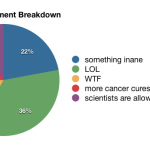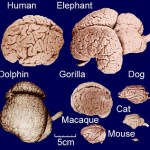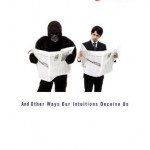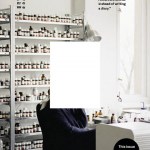Culture
Because I'm sure everybody is as fascinated by blog stats as I am, here's the traffic to this blog for 2010, in graphical form:
In case you can't numerically integrate that in your head, I'll tell you that the total number of pageviews represented there is a bit more than 908,000. We have yet to crack the million mark in any one year, but the total number of pageviews over the history of ScienceBlogs is just short of 3.9 million. Not too shabby.
Looking at the overall traffic states for the five years (five years!) that I've been blogging at ScienceBlogs, the thing I'm happiest about is this…
A bunch of smallish items that have been failing to resolve into full-fledged blog posts for a little while now, thrown together here because I don't have anything better to post this morning:
-- When is doubt, start with self-promotion: Physics World includes How to Teach Physics to Your Dog in their holiday gift books guide, and says wonderfully nice things about it:
Chad Orzel talks to his dog about quantum physics. It is not clear what the dog gets out of this arrangement, but the rest of us ought to be grateful for it, because Orzel's book about their "conversations" is sure to become a…
I'm going to be at a media training session for most of the day. I had hoped to have a long and silly post about physics to schedule today, but, well, that didn't happen. So here's a silly poll to pass the time.
The name of element number 13, chemical symbol Al, is pronounced with how many syllables?survey software
We normally deal in macroscopic quantities of this one, so quantum superpositions of answers are right out.
Eric M. Johnson and I spent about 45 minutes discussing "evolutionary psychology beyond sex" last night, which you can see today on Bloggingheads "Science Saturday."
Or just watch it here:
Ah, Thanksgiving. A day full of turkey, cranberries, pie, and, of course, SCIENCE! After you fill your stomach with gravy and stuffing, stuff your mind with all this great Thanksgiving science.
What's any good Thanksgiving feast without some turkey? Emily Anthes of Wonderland starts the meal off with an offering of thanks for the turkey's contribution to cancer research. But wait! That's not all the science of turkeyhood to be consumed. Feast your minds on my contribution at the Scientific American Guest Blog: the social-cognitive abilities of turkeys. And in case you're feeling particularly…
I've probably gotten a dozen pointers to Gregory Petsko's open letter in support of the humanities, addressed to the President of SUNY-Albany, over the last couple of weeks (the link is to a reposting of the letter at Inside Higher Ed; it was originally on Petsko's own blog). I haven't linked to it or commented on it here, mostly because while I'm broadly sympathetic with his position, after the second use of "[Famous Writer] said [interesting thing] which I'm sure your department of [humanities field] could tell you about, if you hadn't eliminated them," my reaction had shifted significantly…
So, if you look at this picture:
You might be asking yourself "Why does Debbie Harry rate Secret Service protection?" But no, this isn't a photo from some alternate universe where the lead singer of Blondie went on to become leader of the free world, it's part of the Rock Stars of Science campaign by the Geoffrey Beene Foundation. They've just rolled out a new campaign in GQ magazine, putting seventeen prominent biomedical researchers in fancy photo spreads with eight different musicians. It's part of an initiative to raise the profile of science by portraying scientists in a more glamorous…
Having posted not one but two snarky political entries in recent days, I feel like I owe the Internet a couple of ResearchBlogging posts to make up for it. It's the last week of classes here, though, which means I have a lot of frantic work to do. Thus, a frivolous poll inspired by the cinnamon rolls I had with breakfast:
The sugary white stuff on top of baked goods is:survey software
While this will almost certainly get more votes for "I will explain in a comment" than comments-- that seems to be an Internet tradition-- it's still a classical poll, and thus you must choose one and only one…
The oft-discussed 10,000 mile Caesar Salad, used to illustrate the degree to which our food system is drenched in fossil fuels, really is only a piker when it comes to the spaces that food can make you cover.
10K miles by airplane, refrigerator truck, etc... is nothing compared to the distances in time and place you can cover in seconds with food - consider, for example the space in time and distance a single evocative bite can offer you. Home you are transported to your mother's table in Detroit from your home in Lyon with a single bite. Back you travel, 20 years and 5,000 miles to the…
Despite the fact that my research lies at the intersection between cognitive, comparative, and developmental psychology, I am also quite interested in the evolution of our understanding of psychopathology. The ultimate goal of the study of psychopathology is to ground such disorders in brain and body. But our understanding of some pathologies are simply not there yet (though some of our therapeutic interventions still prove effective even if we don't quite understand the etiology of a given disease or disorder). The main conflict in the field that characterizes the study of psychopathology is…
Nick pointed me to a fabulous podcast series by CBC radio called "How To Think About Science." Each episode is a long and fascinating interview with a prominent scholar of science--scientists, philosophers, sociologists, anthropologists, and historians who explore how science is done, how scientists work, and how scientific ideas and facts are communicated. Check it out!
We can babble philosophically about whether or not what we call "red" looks the same from another person's eyes, we can compare the adjectives we use to specify colors--is it maraschino red or cayenne?--but when we're talking to our computers, categorizing flowers, designing objects for mass production, branding a company, or establishing a flag's official colors we have to be able to be specific about which exact shade of red we want.
These days we have standard color systems that define colors as specified mixes of red, green, and blue pixels on screen, specific mixtures of pigments in…
It's not just Scott Kern who thinks that science is only about tedious benchwork and that grad students should be boring robots moving small volumes of liquid around 20 hours a day for the greater good. An unscientific analysis of the 169 comments and numerous comment thumbs ups of Hydrocalypse Industries' most popular video shows that a significant percentage of the commenters who aren't saying something completely inane, off topic, or conspiracy-theory laden are criticizing us for not working hard enough.
I hopefully don't need to go into detail about how many hours we are all actually…
The National Institutes of Health announced that by 2011 it will transfer almost two hundred chimpanzees from the Alamogordo Primate Facility in New Mexico to a lab in San Antonio, Texas, lab for use in invasive research. In 1995, the NIH announced a moratorium on the breeding of chimps in federally-supported labs, and as a result, scientists have developed alternative ways to investigate diseases. But there are still viruses, such as hepatitis C and HIV, that other species simply can't contract. This fact, some argue, makes it prudent to subject chimps to this sort of biomedical testing.…
Prompted by an off-line conversation, a question about the magnum opus of Jim Steinman and Marvin Lee Aday:
Playing "Paradise by the Dashboard Light" at a wedding reception is:online surveys
I'm sure you can come up with lots of songs that would be even less appropriate. Feel free to leave them in the comments.
It's nearly time for classes to resume, which means it's time for a zillion stories about Beloit College's annual Kids These Days List, listing off a bunch of things that this year's entering college class, who were mostly born in 1992, have always taken for granted. A sample:
1. Few in the class know how to write in cursive.
2. Email is just too slow, and they seldom if ever use snail mail.
3. "Go West, Young College Grad" has always implied "and don't stop until you get to Asia...and learn Chinese along the way."
4. Al Gore has always been animated.
5. Los Angelenos have always been trying…
If there is one book that every human should read, it is The Invisible Gorilla, by Chris Chabris and Dan Simons.
I suppose that's a pretty bold statement to make. Let me explain. As a student of psychology, and as someone who studies and writes about the mind, I am overwhelmed with the general perception among the lay public that "social science findings often reaffirm or echo what common sense observations tell us." But the truth is that common sense observations often lead us astray. We have very little insight into the way our minds actually operate. And the thing is, this is likely a…
My Synthetic Aesthetics partner, Sissel Tolaas, is featured in the terrific current issue of the German interview magazine mono.kultur. Her work focuses on smell, exploring the unique smellscapes of different cities, creating provocative scents to show in art galleries, branded "logo" scents for Adidas, "Swedish" scents for Ikea, and therapeutic memory-triggering scents, part of the healing process for patients dealing with traumatic experiences. Until we have smell-o-vision, her work is almost aggressively analog--"beyond what is seen and heard to something indiscernible yet more…
One of the commemorate Eyjafjallajökull ash stamps being issued by the Icelandic Post - made with ash from the eruption itself.
Many Eruptions readers would consider themselves volcanophiles (or volcanificiandos?) and I would venture to guess there is a subset of volcano enthusiasts who are also philatelists as well. A philatelist (for those of you out of that select circle) is a stamp enthusiast - a stamp collector. Now, in our modern interwebbed world, I wonder if stamp collecting as a hobby has diminished, but that doesn't stop countries from still trying to make some money from stamp…
GOOD has an interesting series of articles called No More Dirty Looks about the cosmetics that we use every day and what options are available for safer, more environmentally sound beauty products, without any toxic carcinogens, endocrine disruptors, or petrochemicals. Yesterday they linked to a terrifying video from The Story of Stuff Project describing the limits of regulation on toxic chemicals used in everyday products from lipstick to baby shampoo:
The best line of the video I think comes in about halfway through, when talking about hair relaxers and skin whiteners advertised to young…

